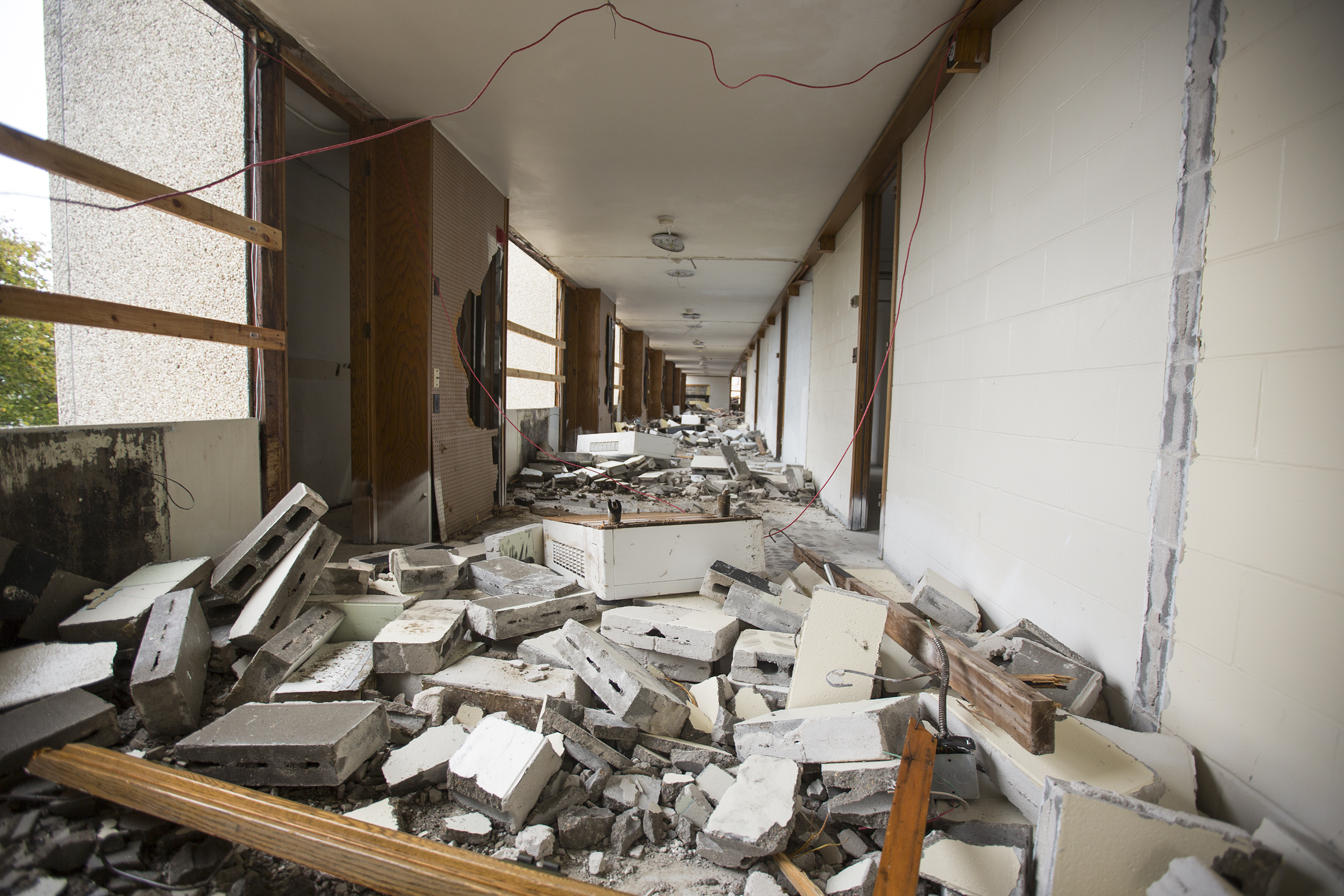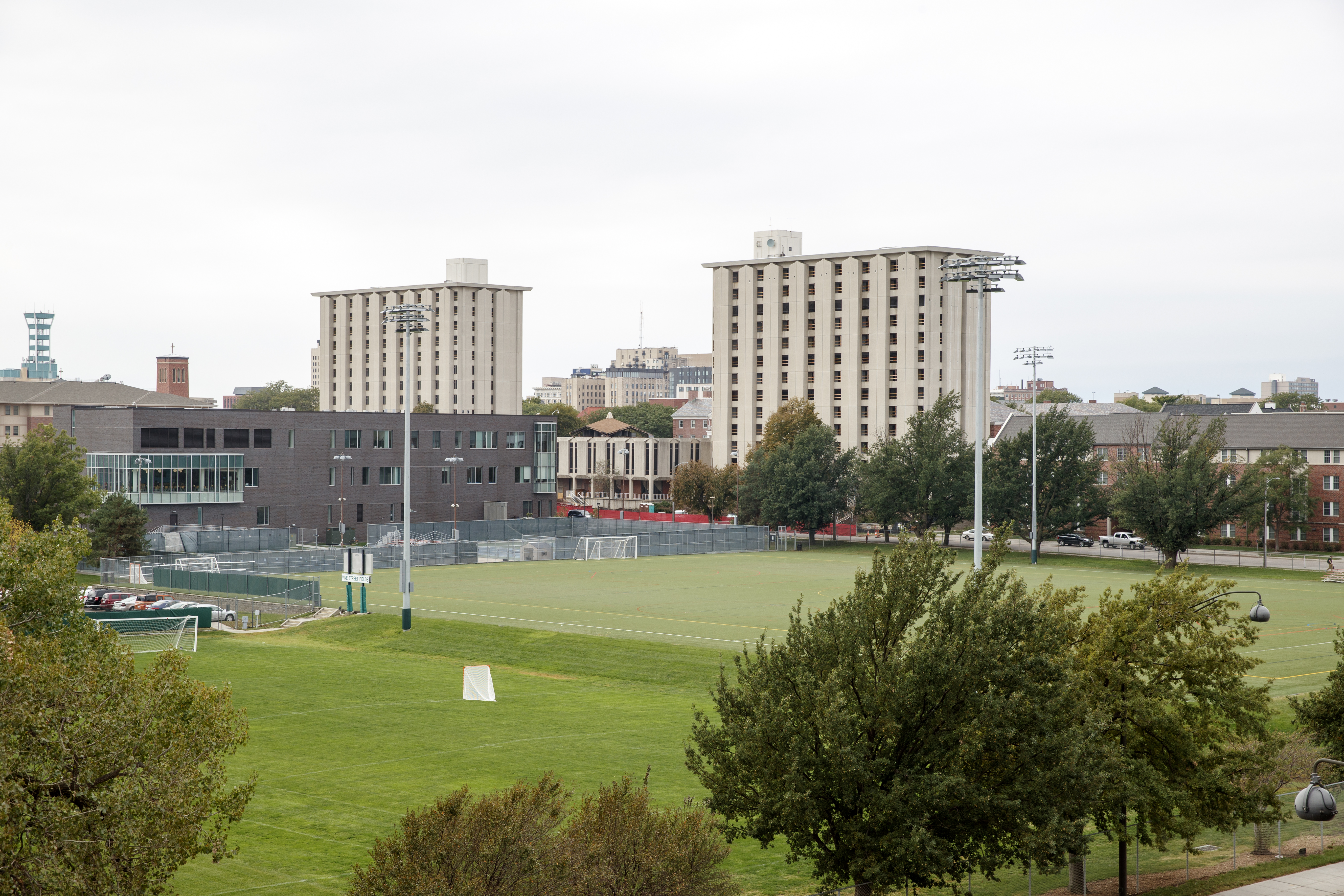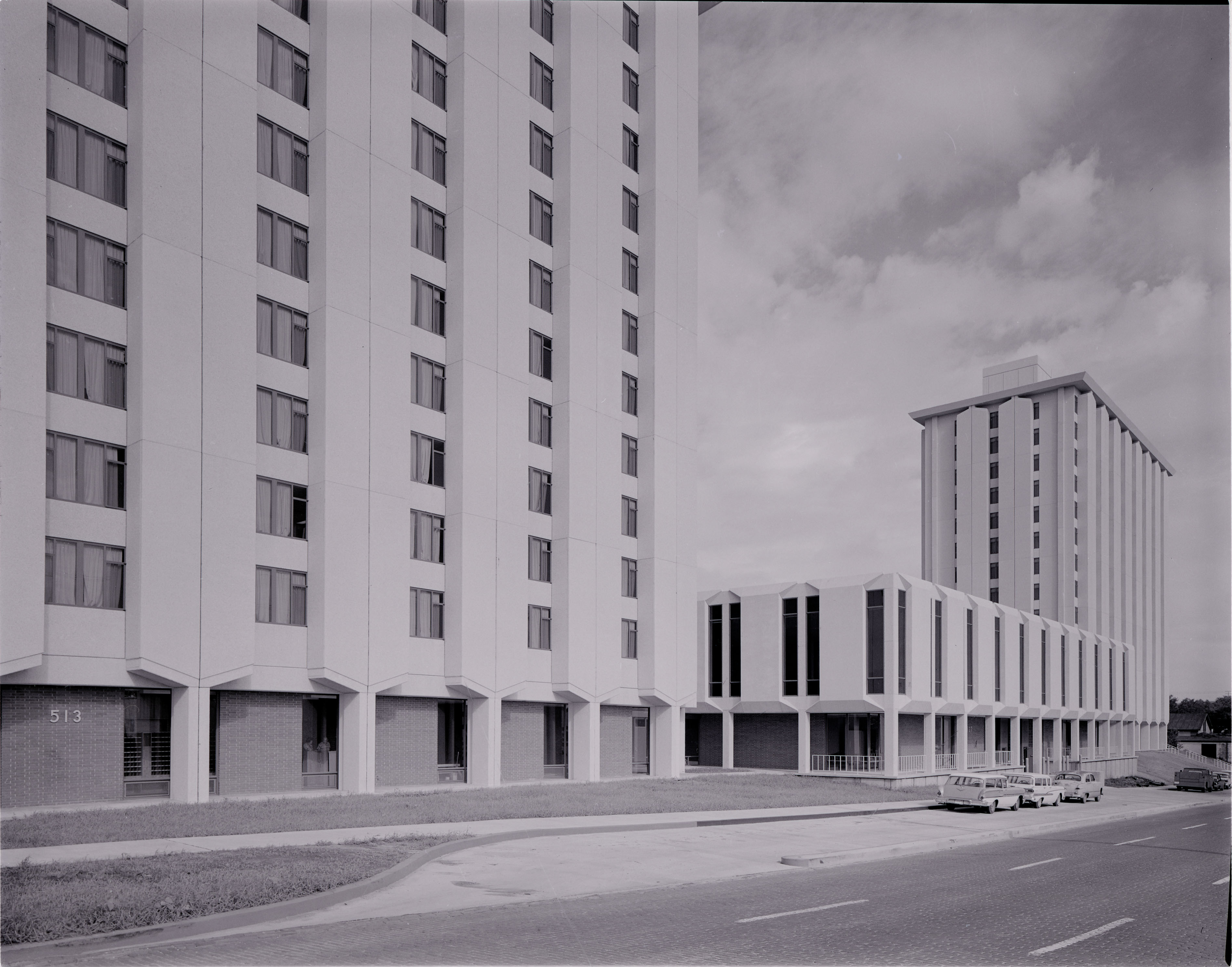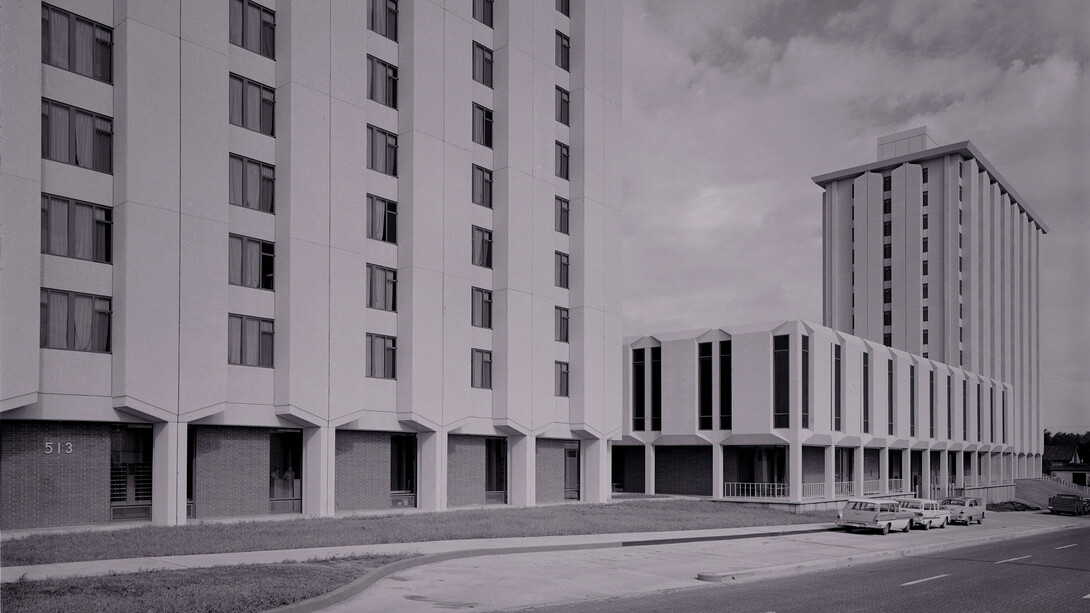
The end is near for the university’s oldest high-rise residence hall complex.
After more than two years of planning and consultation, the University of Nebraska–Lincoln has finalized plans for the razing of Cather Hall, Pound Hall and the attached Cather-Pound Dining Center.
The dining center will be the first to go, with removal via heavy construction equipment starting Oct. 30. Once cleared, the dining center space will provide a primary landing area for the 13-story Cather and Pound towers, which will be knocked down via a controlled implosion on the morning of Dec. 22.
“The primary focus through this entire process has been on public safety and completing the implosion with minimal disruption to the campus and Lincoln community,” said Sue Gildersleeve, director of Housing. “Now, as we move forward with the final phase, we need the community to be aware of and prepare for the actual implosion and safety measures that will be in place for Dec. 22.”

The actual implosion time is scheduled for 9 a.m. A backup date of Dec. 23, with the same schedule of Dec. 22, has also been planned. Access a schedule outlining the razing process.
University officials selected these dates to coincide with reduced activity on campus. The implosion will take place in the week following December commencement activities, a time when no classes are held and the vast majority of students have left for Nebraska’s winter break. In addition, Dec. 22 is the day before the university’s winter shutdown, which continues through Jan. 2.
“In general, this is the safest time we could complete the implosion,” said Chad Lea, lead project manager and architect for Facilities Planning and Construction. “This schedule will also be the least disruptive to the campus community, particularly to students.”
The winter schedule allows for debris removal at a time when most campus windows are closed, reducing dust impacts. The site will also be cleared in time for installation of new landscaping in late spring or summer.
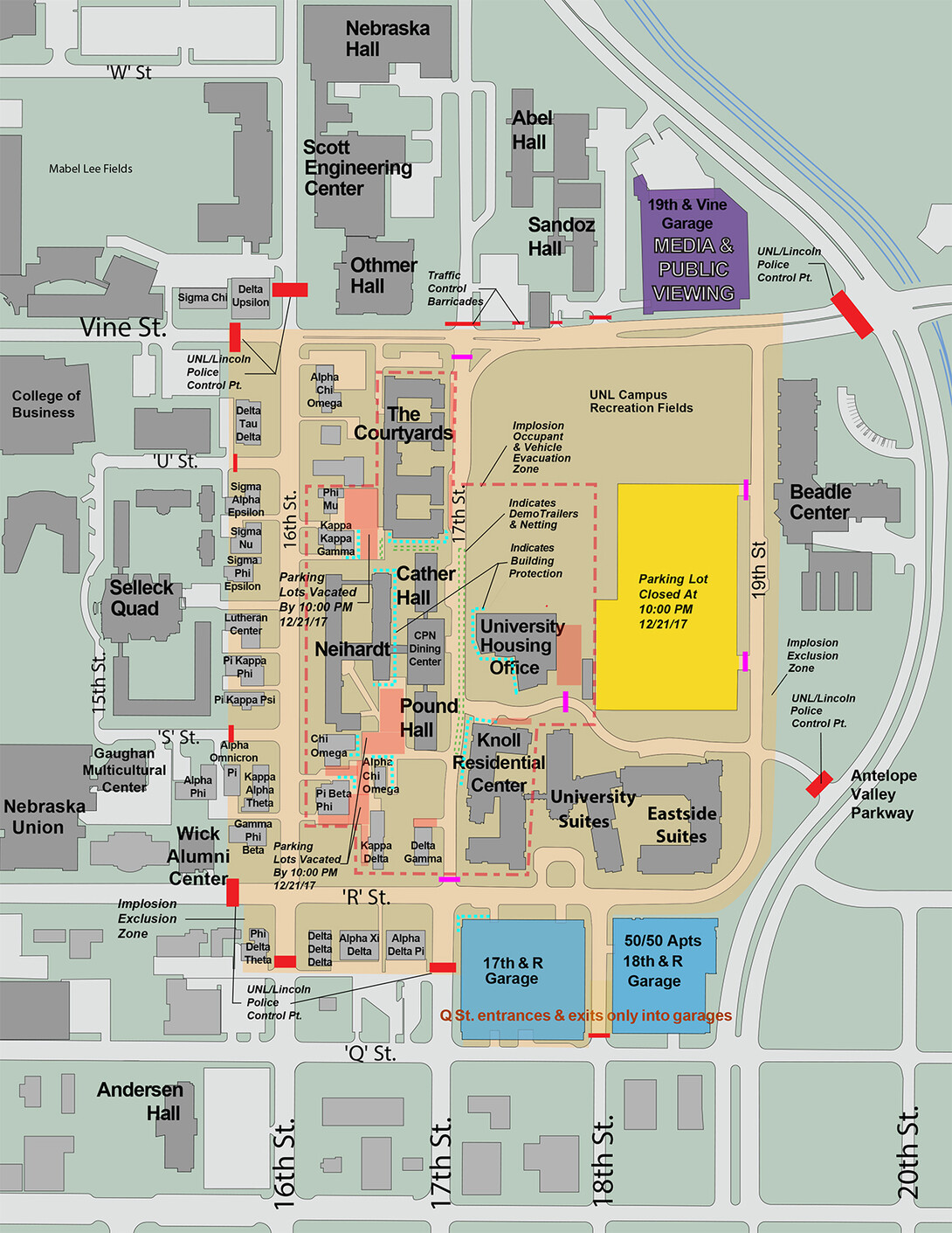
From 6 a.m. to noon on Dec. 22, two perimeters — an evacuation zone and an implosion control zone — will be established around Cather and Pound halls to protect the public from the razing.
The interior perimeter (evacuation zone) will encompass about nine square blocks and include buildings nearest to the Cather-Pound site, which is in the 500 block of North 17th Street. Only members of the implosion crew will be allowed inside of the evacuation zone until the all-clear is sounded the day of the razing.
The second perimeter (exclusion zone) will include about 16 square blocks and stretch between Vine and R streets to the north and south, and from Greek row on the west side of 16th Street to the Beadle Center on the east side of 19th Street. Individuals within the implosion control zone must remain inside buildings during the entire razing schedule.
A complete list of buildings within each zone is below.
Roadways into the implosion control zone will be blocked as of 6 a.m. Dec. 22 and should reopen by noon. Those roadways through campus include Vine, R, 16th, 17th and 19th streets.
All parking lots within the evacuation zone — including the university-run Area A/R1 lot on 19th Street (immediately west of the Beadle Center) — must be vacated by 10 p.m. Dec. 21.
Faculty, staff and students with permits for the Area A/R1 lot will be allowed to park in any campus parking garage for the day of the implosion. Students leaving for winter break prior to Dec. 22 and who use the Area A/R1 lot are being asked to park vehicles in the 17th and R parking garage, which will be open for their use from Dec. 11 to Jan. 5.
A viewing area will be available to the public and media atop the university’s 19th and Vine streets parking garage. Free parking will be available in the garage for the day of the implosion.
The university also plans to offer a live view of the implosion online. The web address will be announced as the razing date nears.
The demolition will be completed by Ark Wrecking of Tulsa, Oklahoma, and Controlled Demolition of Phoenix, Maryland. Prep work on the buildings, which is ongoing, started in May.

To protect nearby buildings from damage and dust, a number of safety measures are being used.
Due to its proximity to nearby buildings, a cabling system will link the precast concrete façade of Cather Hall. These cables will hold the panels to the structure, not allowing them to fall away freely and cause damage to Neihardt and Courtyards residence halls.
To further protect Courtyards, 40-foot-long steel shipping containers — the same used to haul items via truck, train and ship — will be used to create a wall between the apartment-style residence facility and Cather Hall. The containers will be in place before Nebraska’s Thanksgiving break, which begins Nov. 22.
A protective fabric will be used to guard nearby buildings from dust and other small debris. Buildings that will be protected by the fabric include Courtyards, Kappa Kappa Gamma sorority, Neihardt Hall, Chi Omega sorority, Pi Beta Phi sorority, Alpha Omega sorority, Knoll Residential Center, Willa Cather Dining Complex and 17th and R garage.
The fabric — which will cause an obstructed view from windows — will be positioned on buildings the week of Dec. 17. It will be removed after the implosion to allow for damage inspection.
Due to the implosion and debris removal, 17th Street will close to through traffic between R and Vine streets starting Oct. 18. Limited access to campus buildings near the Cather-Pound project will be available. The closure will continue through at least spring.
Demolition cleanup and site restoration are anticipated to continue through July 2018.
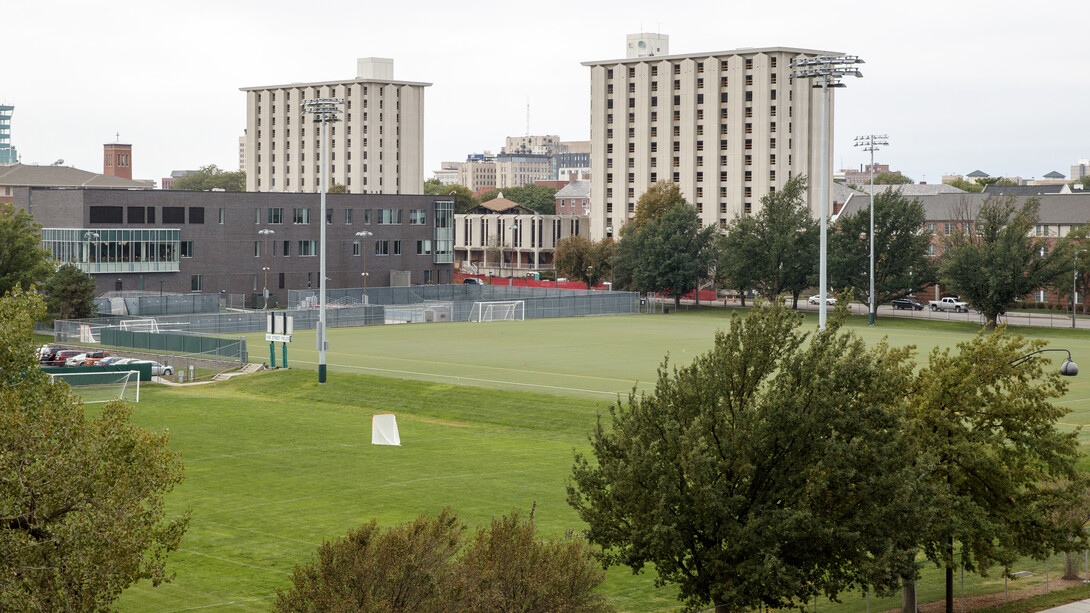
The Cather-Pound site has been designated as a building space on the university’s master plan. However, no immediate plans for a new building have been made and the site will be converted into a temporary green space.
A study completed in 2010 concluded that renovation of the Cather-Pound complex was not recommended due to the high cost of renovation compared to the cost of new construction. University Suites and Eastside Suites, which opened in 2013 and 2014, respectively, were built as replacement housing for Cather and Pound halls. During summer 2017, Nebraska opened the Willa Cather Dining Complex to replace the Cather-Pound Dining Center.
The Cather-Pound complex was built in 1963 as the university’s first high-rise residence hall facility. Cather Hall closed in 2014, while Pound Hall remained in service through the 2016-17 academic year.
The university will continue to provide updates about the project as the implosion date nears.

Buildings within the Cather-Pound Razing Zones
Evacuation Zone Buildings
No one is allowed inside of these buildings from 6 a.m. to noon on Dec. 22
University buildings — Courtyards (south half), Knoll Residential Center, Neihardt Hall, Willa Cather Dining Complex
Greek houses — Alpha Omega, Chi Omega, Delta Gamma, Kappa Delta, Kappa Kappa Gamma, Phi Mu, Pi Beta Phi
Exclusion Zone Buildings
Individuals in these buildings must shelter in place from 7 a.m. to noon on Dec. 22
University buildings — 17th and R parking garage, 18th and R parking garage, Courtyard (north half), East Side Suites, University Suites
Greek houses — Alpha Chi Omega, Alpha Delta Pi, Alpha Omicron Pi, Alpha Xi Delta, Delta Delta Delta, Delta Tau Delta, Gamma Phi Beta, Kappa Alpha Theta, Phi Delta Theta, Pi Kappa Phi, Pi Kappa Psi, Sigma Alpha Epsilon, Sigma Nu and Sigma Phi Epsilon
Private buildings — 50/50 apartment complex, Lewis-Syford House, Lutheran Center

